1998 OPEL FRONTERA battery
[x] Cancel search: batteryPage 1316 of 6000

6E–199 ENGINE DRIVEABILITY AND EMISSIONS
Conditions for Clearing the MIL/DTC
DTC P0341 can be cleared by using Tech 2 “Clear Info”
function or by disconnecting the PCM battery feed.
Diagnostic Aids
An intermittent may be caused by a poor connection,
rubbed-through wire insulation or a wire broken inside the
insulation. Check for:
Poor connection – Inspect the PCM harness and
connectors for improper mating, broken locks,
improperly formed or damaged terminals, and poor
terminal-to-wire connection.
Damaged harness – Inspect the wiring harness for
damage. If the harness appears to be OK, disconnect
the PCM, turn the ignition on and observe a voltmeter
connected to the CMP signal circuit at the PCM
harness connector while moving connectors andwiring harnesses related to the ICM and the CMP
sensor. A change in voltage will indicate the location
of the fault.
Reviewing the Failure Records vehicle mileage since the
diagnostic test last failed may help determine how often
the condition that caused the DTC to be set occurs. This
may assist in diagnosing the condition.
Test Description
Number(s) below refer to the step number(s) on the
Diagnostic Chart.
2. Ensures that the fault is present.
12.Determines whether the fault is being caused by a
missing camshaft magnet or a faulty sensor. The
voltage measured in this step should read around 4
volts, toggling to near 0 volts when the CMP sensor
interfaces with the camshaft magnet.
Page 1320 of 6000
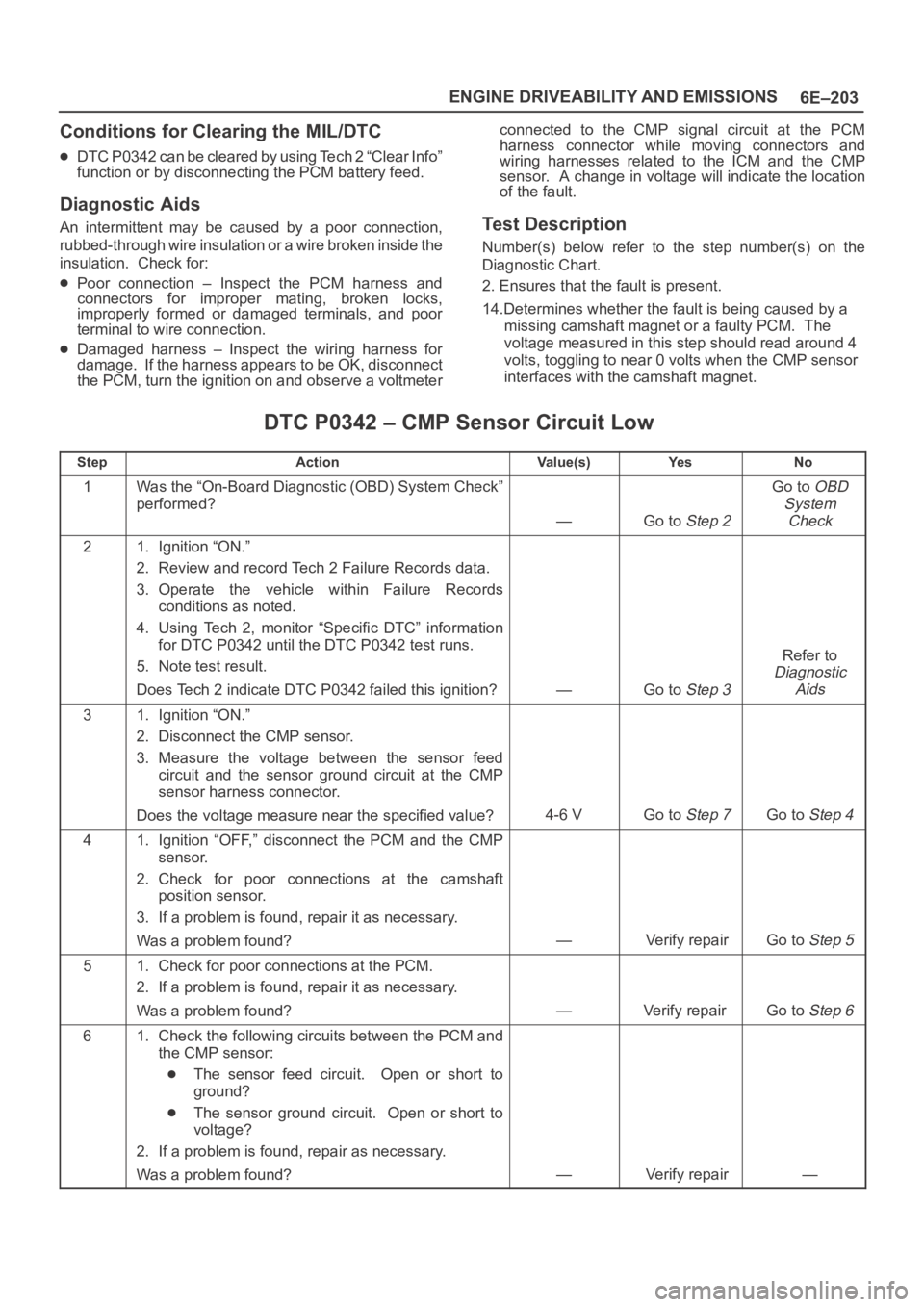
6E–203 ENGINE DRIVEABILITY AND EMISSIONS
Conditions for Clearing the MIL/DTC
DTC P0342 can be cleared by using Tech 2 “Clear Info”
function or by disconnecting the PCM battery feed.
Diagnostic Aids
An intermittent may be caused by a poor connection,
rubbed-through wire insulation or a wire broken inside the
insulation. Check for:
Poor connection – Inspect the PCM harness and
connectors for improper mating, broken locks,
improperly formed or damaged terminals, and poor
terminal to wire connection.
Damaged harness – Inspect the wiring harness for
damage. If the harness appears to be OK, disconnect
the PCM, turn the ignition on and observe a voltmeterconnected to the CMP signal circuit at the PCM
harness connector while moving connectors and
wiring harnesses related to the ICM and the CMP
sensor. A change in voltage will indicate the location
of the fault.
Test Description
Number(s) below refer to the step number(s) on the
Diagnostic Chart.
2. Ensures that the fault is present.
14.Determines whether the fault is being caused by a
missing camshaft magnet or a faulty PCM. The
voltage measured in this step should read around 4
volts, toggling to near 0 volts when the CMP sensor
interfaces with the camshaft magnet.
DTC P0342 – CMP Sensor Circuit Low
StepActionVa l u e ( s )Ye sNo
1Was the “On-Board Diagnostic (OBD) System Check”
performed?
—Go to Step 2
Go to OBD
System
Check
21. Ignition “ON.”
2. Review and record Tech 2 Failure Records data.
3. Operate the vehicle within Failure Records
conditions as noted.
4. Using Tech 2, monitor “Specific DTC” information
for DTC P0342 until the DTC P0342 test runs.
5. Note test result.
Does Tech 2 indicate DTC P0342 failed this ignition?
—Go to Step 3
Refer to
Diagnostic
Aids
31. Ignition “ON.”
2. Disconnect the CMP sensor.
3. Measure the voltage between the sensor feed
circuit and the sensor ground circuit at the CMP
sensor harness connector.
Does the voltage measure near the specified value?
4-6 VGo to Step 7Go to Step 4
41. Ignition “OFF,” disconnect the PCM and the CMP
sensor.
2. Check for poor connections at the camshaft
position sensor.
3. If a problem is found, repair it as necessary.
Was a problem found?
—Verify repairGo to Step 5
51. Check for poor connections at the PCM.
2. If a problem is found, repair it as necessary.
Was a problem found?
—Verify repair Go to Step 6
61. Check the following circuits between the PCM and
the CMP sensor:
The sensor feed circuit. Open or short to
ground?
The sensor ground circuit. Open or short to
voltage?
2. If a problem is found, repair as necessary.
Was a problem found?
—Verify repair—
Page 1323 of 6000
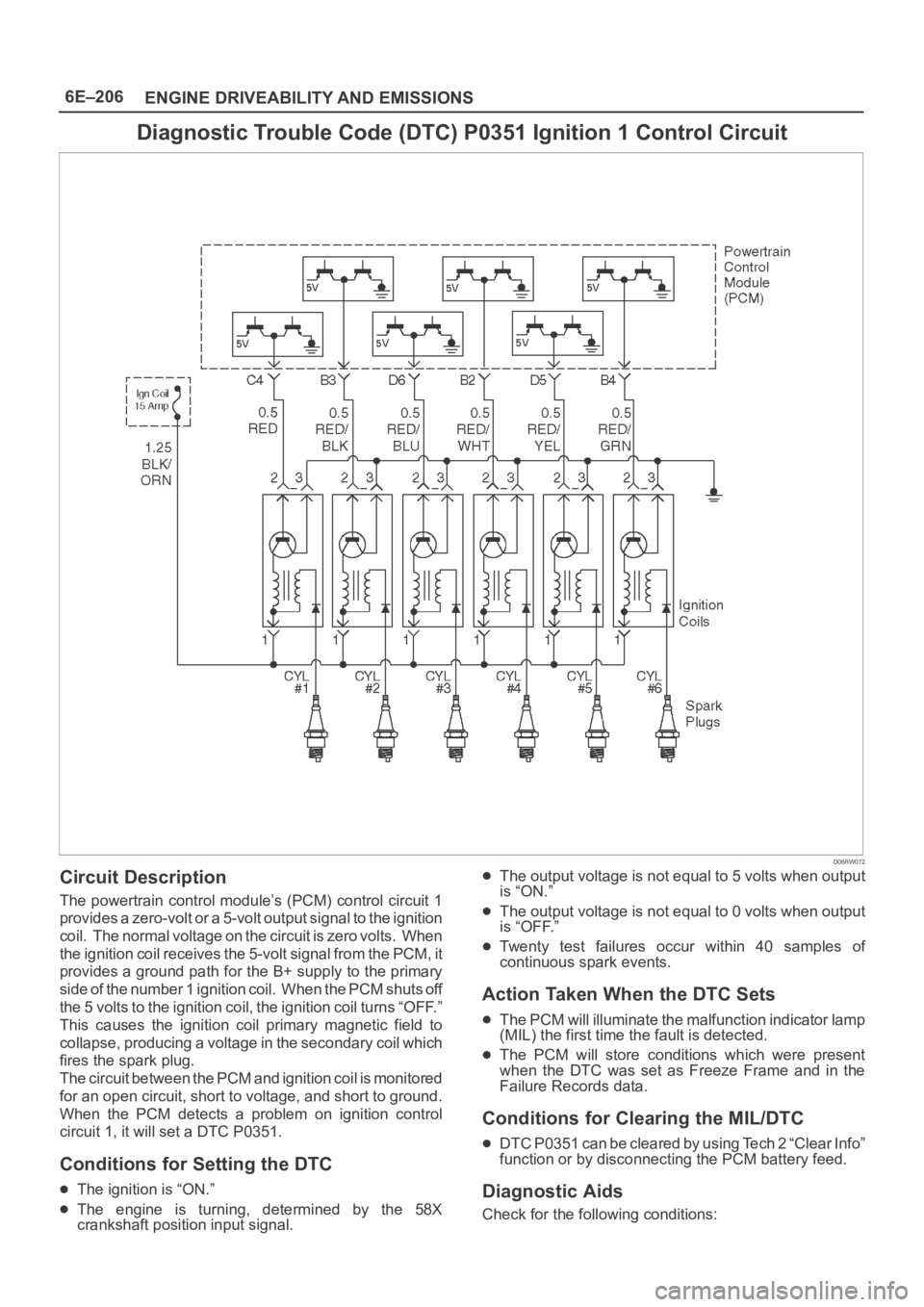
6E–206
ENGINE DRIVEABILITY AND EMISSIONS
Diagnostic Trouble Code (DTC) P0351 Ignition 1 Control Circuit
D06RW072
Circuit Description
The powertrain control module’s (PCM) control circuit 1
provides a zero-volt or a 5-volt output signal to the ignition
coil. The normal voltage on the circuit is zero volts. When
the ignition coil receives the 5-volt signal from the PCM, it
provides a ground path for the B+ supply to the primary
side of the number 1 ignition coil. When the PCM shuts off
the 5 volts to the ignition coil, the ignition coil turns “OFF.”
This causes the ignition coil primary magnetic field to
collapse, producing a voltage in the secondary coil which
fires the spark plug.
The circuit between the PCM and ignition coil is monitored
for an open circuit, short to voltage, and short to ground.
When the PCM detects a problem on ignition control
circuit 1, it will set a DTC P0351.
Conditions for Setting the DTC
The ignition is “ON.”
The engine is turning, determined by the 58X
crankshaft position input signal.
The output voltage is not equal to 5 volts when output
is “ON.”
The output voltage is not equal to 0 volts when output
is “OFF.”
Twenty test failures occur within 40 samples of
continuous spark events.
Action Taken When the DTC Sets
The PCM will illuminate the malfunction indicator lamp
(MIL) the first time the fault is detected.
The PCM will store conditions which were present
when the DTC was set as Freeze Frame and in the
Failure Records data.
Conditions for Clearing the MIL/DTC
DTC P0351 can be cleared by using Tech 2 “Clear Info”
function or by disconnecting the PCM battery feed.
Diagnostic Aids
Check for the following conditions:
Page 1326 of 6000
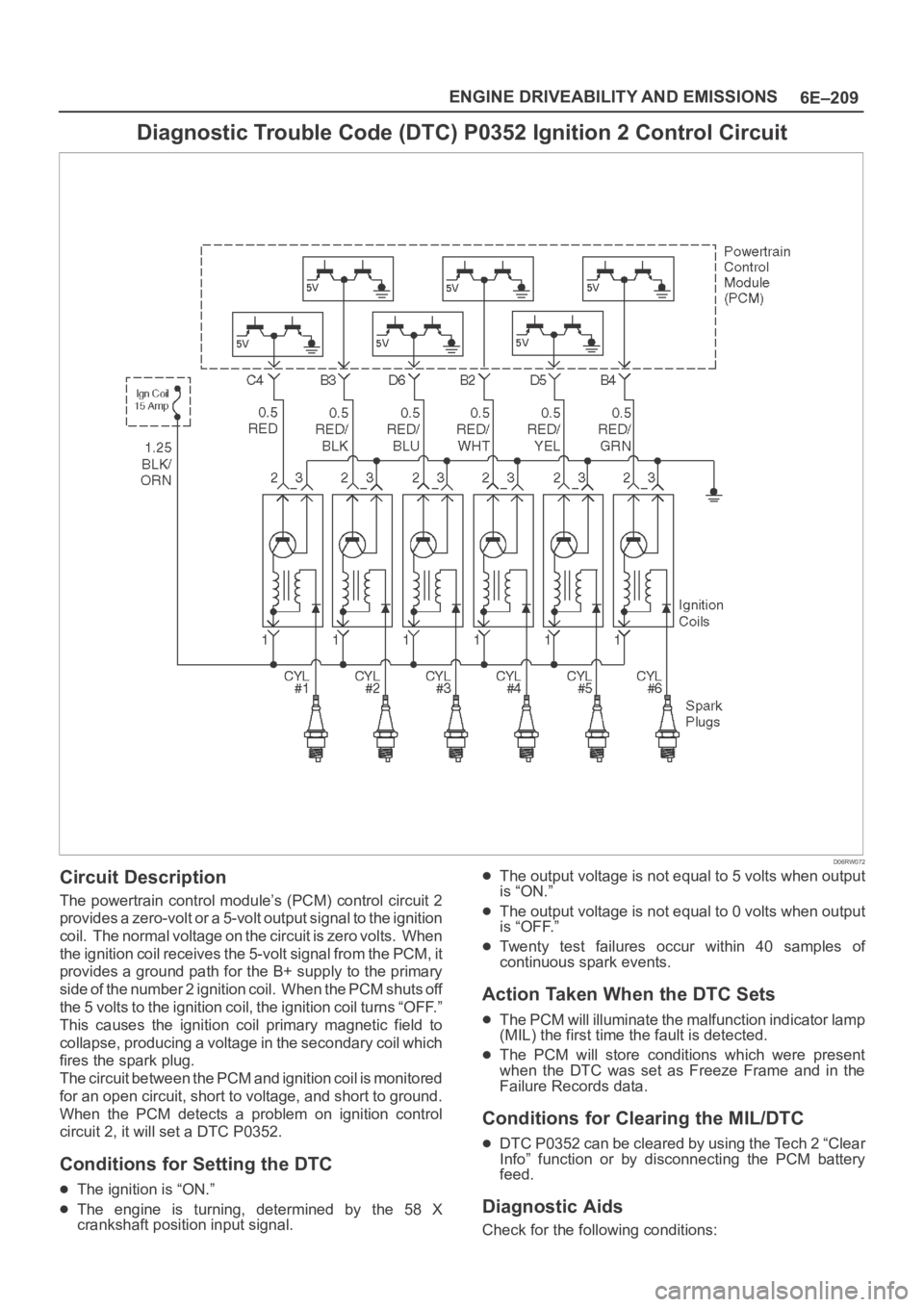
6E–209 ENGINE DRIVEABILITY AND EMISSIONS
Diagnostic Trouble Code (DTC) P0352 Ignition 2 Control Circuit
D06RW072
Circuit Description
The powertrain control module’s (PCM) control circuit 2
provides a zero-volt or a 5-volt output signal to the ignition
coil. The normal voltage on the circuit is zero volts. When
the ignition coil receives the 5-volt signal from the PCM, it
provides a ground path for the B+ supply to the primary
side of the number 2 ignition coil. When the PCM shuts off
the 5 volts to the ignition coil, the ignition coil turns “OFF.”
This causes the ignition coil primary magnetic field to
collapse, producing a voltage in the secondary coil which
fires the spark plug.
The circuit between the PCM and ignition coil is monitored
for an open circuit, short to voltage, and short to ground.
When the PCM detects a problem on ignition control
circuit 2, it will set a DTC P0352.
Conditions for Setting the DTC
The ignition is “ON.”
The engine is turning, determined by the 58 X
crankshaft position input signal.
The output voltage is not equal to 5 volts when output
is “ON.”
The output voltage is not equal to 0 volts when output
is “OFF.”
Twenty test failures occur within 40 samples of
continuous spark events.
Action Taken When the DTC Sets
The PCM will illuminate the malfunction indicator lamp
(MIL) the first time the fault is detected.
The PCM will store conditions which were present
when the DTC was set as Freeze Frame and in the
Failure Records data.
Conditions for Clearing the MIL/DTC
DTC P0352 can be cleared by using the Tech 2 “Clear
Info” function or by disconnecting the PCM battery
feed.
Diagnostic Aids
Check for the following conditions:
Page 1329 of 6000
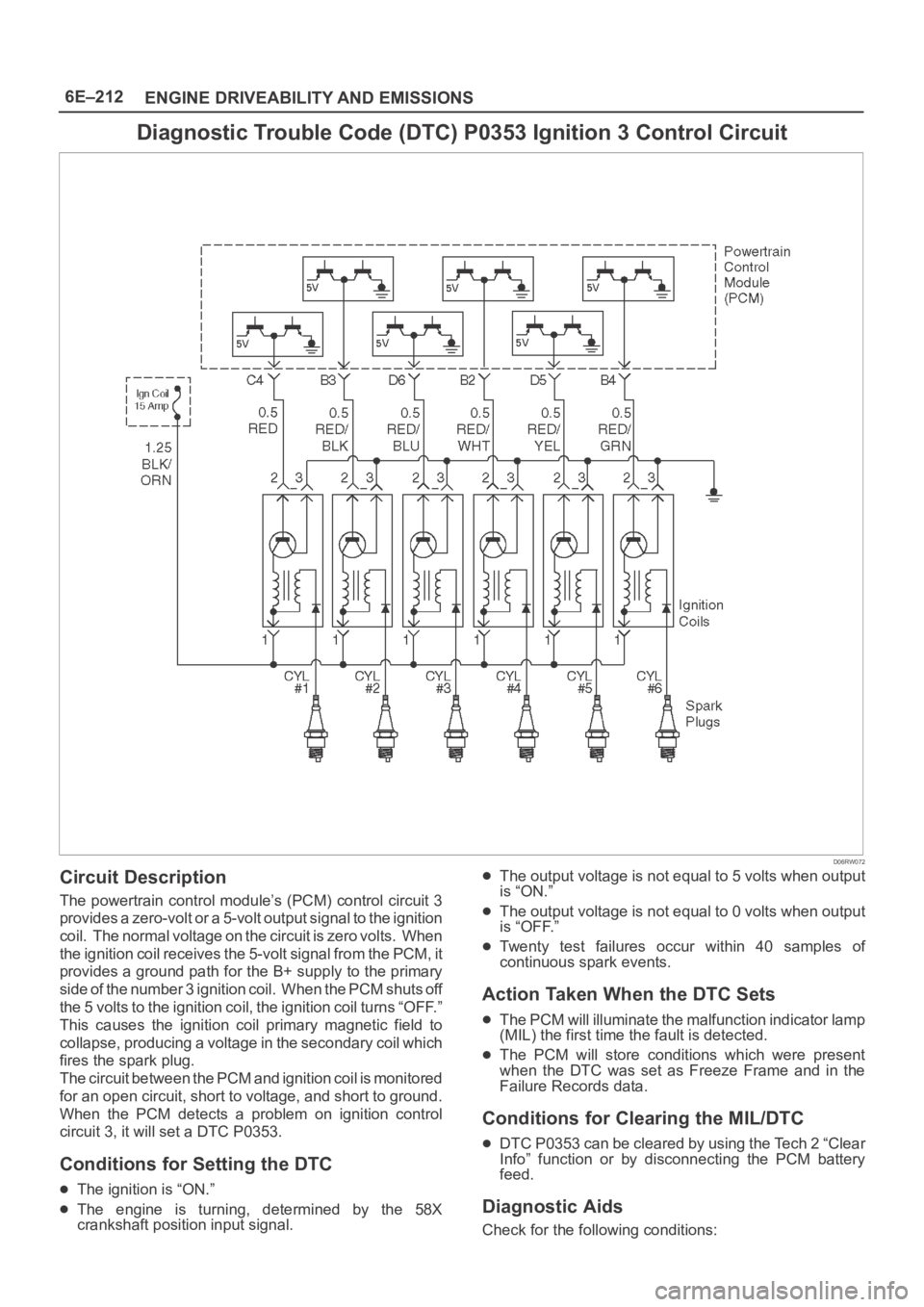
6E–212
ENGINE DRIVEABILITY AND EMISSIONS
Diagnostic Trouble Code (DTC) P0353 Ignition 3 Control Circuit
D06RW072
Circuit Description
The powertrain control module’s (PCM) control circuit 3
provides a zero-volt or a 5-volt output signal to the ignition
coil. The normal voltage on the circuit is zero volts. When
the ignition coil receives the 5-volt signal from the PCM, it
provides a ground path for the B+ supply to the primary
side of the number 3 ignition coil. When the PCM shuts off
the 5 volts to the ignition coil, the ignition coil turns “OFF.”
This causes the ignition coil primary magnetic field to
collapse, producing a voltage in the secondary coil which
fires the spark plug.
The circuit between the PCM and ignition coil is monitored
for an open circuit, short to voltage, and short to ground.
When the PCM detects a problem on ignition control
circuit 3, it will set a DTC P0353.
Conditions for Setting the DTC
The ignition is “ON.”
The engine is turning, determined by the 58X
crankshaft position input signal.
The output voltage is not equal to 5 volts when output
is “ON.”
The output voltage is not equal to 0 volts when output
is “OFF.”
Twenty test failures occur within 40 samples of
continuous spark events.
Action Taken When the DTC Sets
The PCM will illuminate the malfunction indicator lamp
(MIL) the first time the fault is detected.
The PCM will store conditions which were present
when the DTC was set as Freeze Frame and in the
Failure Records data.
Conditions for Clearing the MIL/DTC
DTC P0353 can be cleared by using the Tech 2 “Clear
Info” function or by disconnecting the PCM battery
feed.
Diagnostic Aids
Check for the following conditions:
Page 1332 of 6000
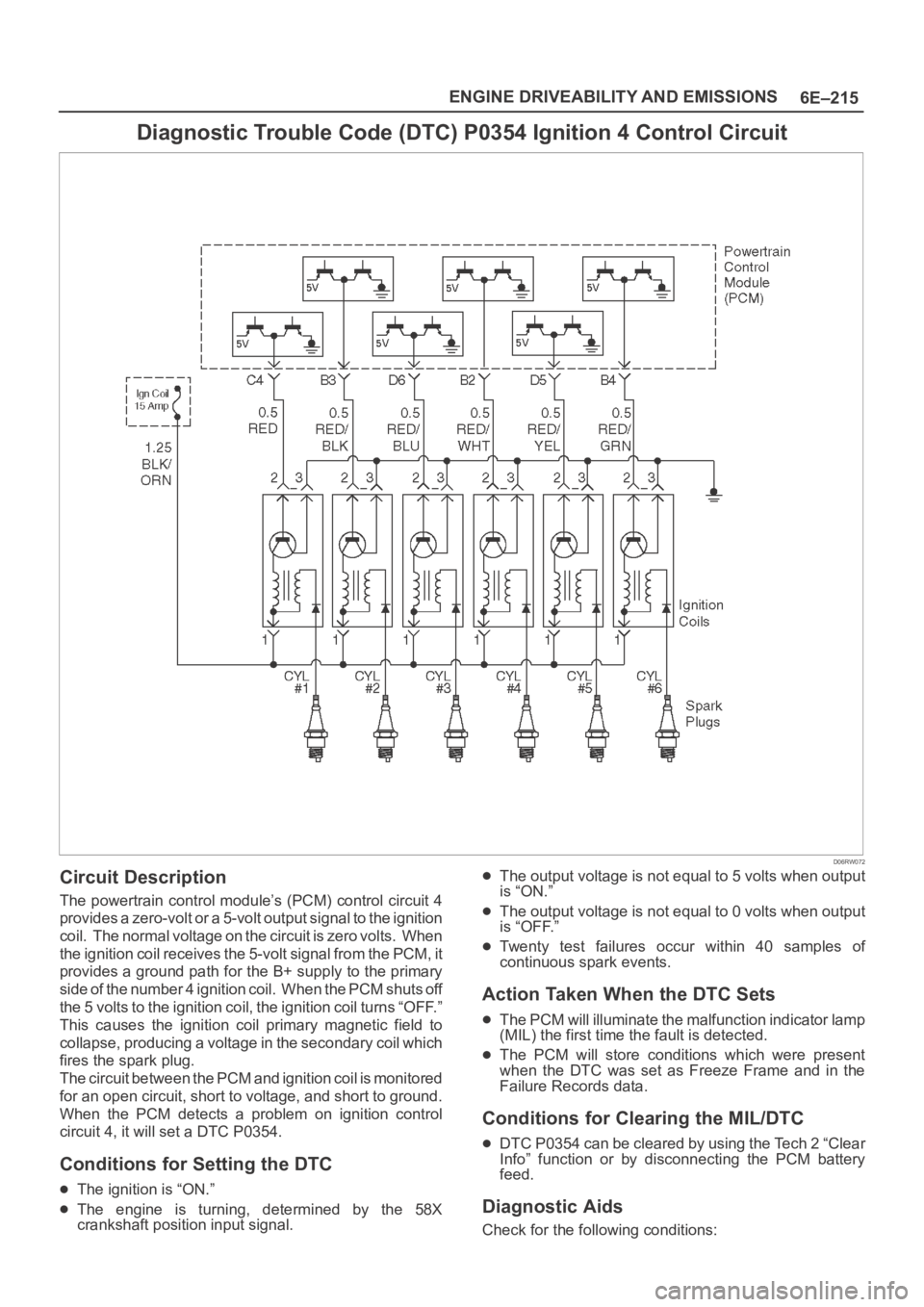
6E–215 ENGINE DRIVEABILITY AND EMISSIONS
Diagnostic Trouble Code (DTC) P0354 Ignition 4 Control Circuit
D06RW072
Circuit Description
The powertrain control module’s (PCM) control circuit 4
provides a zero-volt or a 5-volt output signal to the ignition
coil. The normal voltage on the circuit is zero volts. When
the ignition coil receives the 5-volt signal from the PCM, it
provides a ground path for the B+ supply to the primary
side of the number 4 ignition coil. When the PCM shuts off
the 5 volts to the ignition coil, the ignition coil turns “OFF.”
This causes the ignition coil primary magnetic field to
collapse, producing a voltage in the secondary coil which
fires the spark plug.
The circuit between the PCM and ignition coil is monitored
for an open circuit, short to voltage, and short to ground.
When the PCM detects a problem on ignition control
circuit 4, it will set a DTC P0354.
Conditions for Setting the DTC
The ignition is “ON.”
The engine is turning, determined by the 58X
crankshaft position input signal.
The output voltage is not equal to 5 volts when output
is “ON.”
The output voltage is not equal to 0 volts when output
is “OFF.”
Twenty test failures occur within 40 samples of
continuous spark events.
Action Taken When the DTC Sets
The PCM will illuminate the malfunction indicator lamp
(MIL) the first time the fault is detected.
The PCM will store conditions which were present
when the DTC was set as Freeze Frame and in the
Failure Records data.
Conditions for Clearing the MIL/DTC
DTC P0354 can be cleared by using the Tech 2 “Clear
Info” function or by disconnecting the PCM battery
feed.
Diagnostic Aids
Check for the following conditions:
Page 1335 of 6000
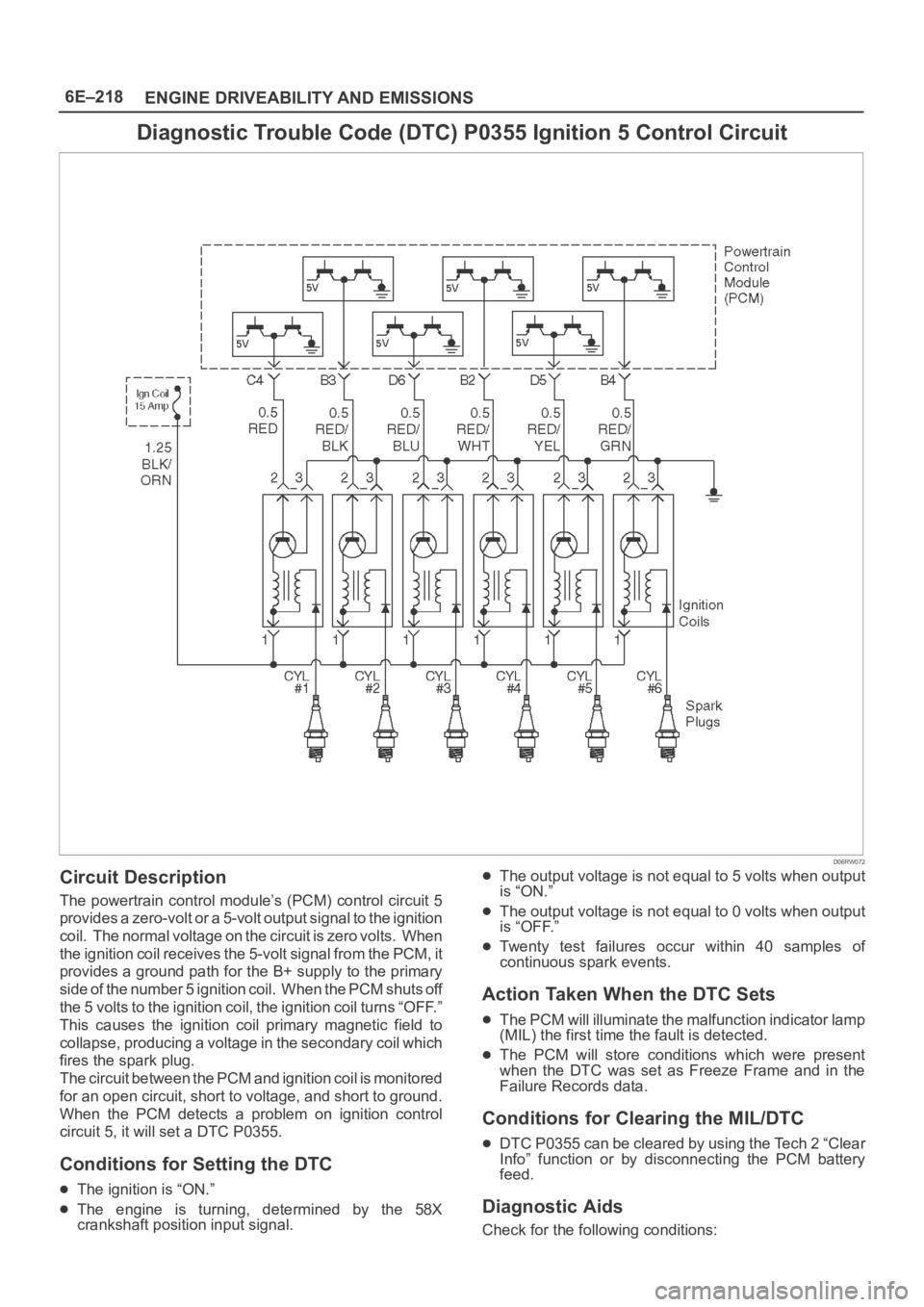
6E–218
ENGINE DRIVEABILITY AND EMISSIONS
Diagnostic Trouble Code (DTC) P0355 Ignition 5 Control Circuit
D06RW072
Circuit Description
The powertrain control module’s (PCM) control circuit 5
provides a zero-volt or a 5-volt output signal to the ignition
coil. The normal voltage on the circuit is zero volts. When
the ignition coil receives the 5-volt signal from the PCM, it
provides a ground path for the B+ supply to the primary
side of the number 5 ignition coil. When the PCM shuts off
the 5 volts to the ignition coil, the ignition coil turns “OFF.”
This causes the ignition coil primary magnetic field to
collapse, producing a voltage in the secondary coil which
fires the spark plug.
The circuit between the PCM and ignition coil is monitored
for an open circuit, short to voltage, and short to ground.
When the PCM detects a problem on ignition control
circuit 5, it will set a DTC P0355.
Conditions for Setting the DTC
The ignition is “ON.”
The engine is turning, determined by the 58X
crankshaft position input signal.
The output voltage is not equal to 5 volts when output
is “ON.”
The output voltage is not equal to 0 volts when output
is “OFF.”
Twenty test failures occur within 40 samples of
continuous spark events.
Action Taken When the DTC Sets
The PCM will illuminate the malfunction indicator lamp
(MIL) the first time the fault is detected.
The PCM will store conditions which were present
when the DTC was set as Freeze Frame and in the
Failure Records data.
Conditions for Clearing the MIL/DTC
DTC P0355 can be cleared by using the Tech 2 “Clear
Info” function or by disconnecting the PCM battery
feed.
Diagnostic Aids
Check for the following conditions:
Page 1338 of 6000
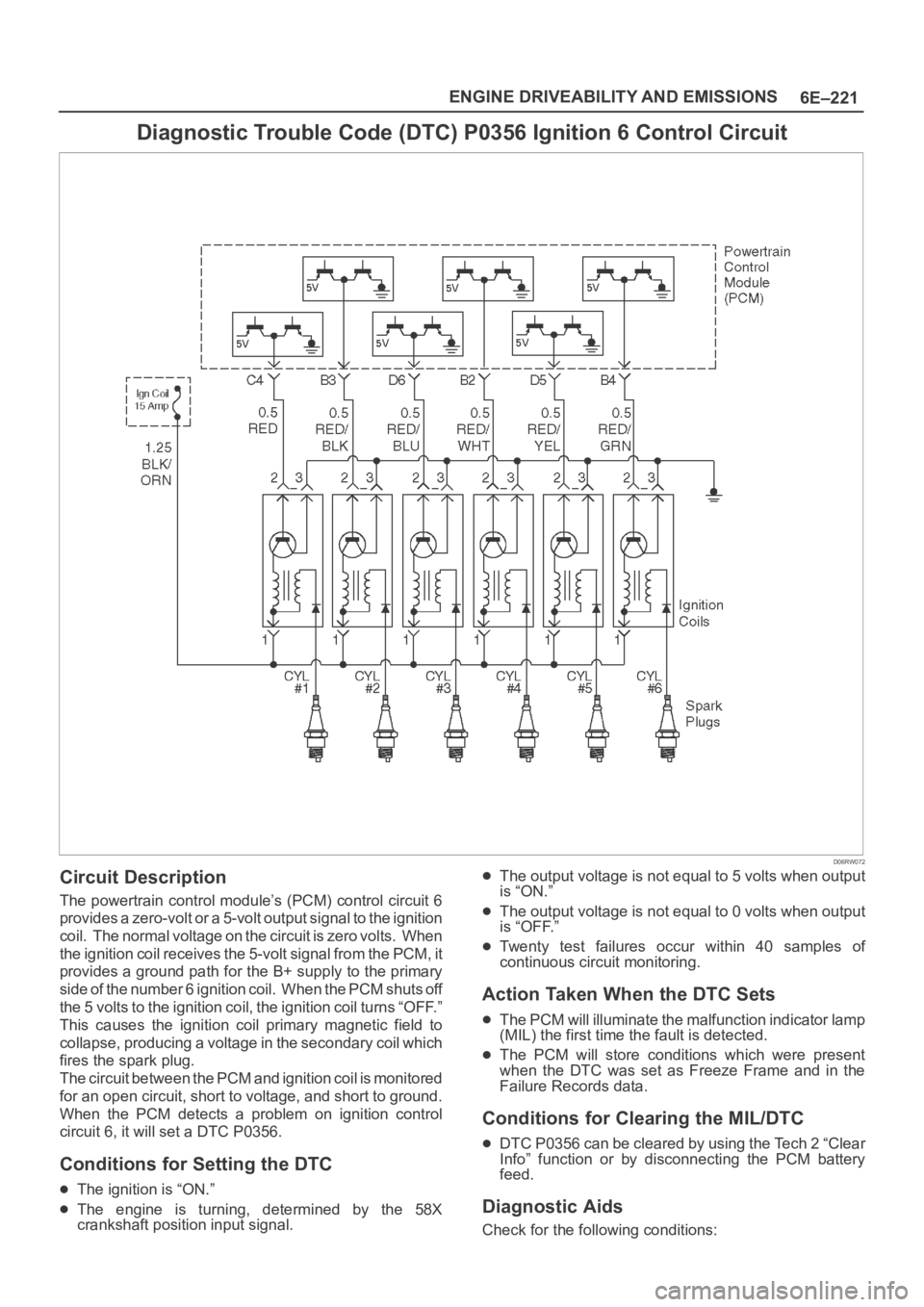
6E–221 ENGINE DRIVEABILITY AND EMISSIONS
Diagnostic Trouble Code (DTC) P0356 Ignition 6 Control Circuit
D06RW072
Circuit Description
The powertrain control module’s (PCM) control circuit 6
provides a zero-volt or a 5-volt output signal to the ignition
coil. The normal voltage on the circuit is zero volts. When
the ignition coil receives the 5-volt signal from the PCM, it
provides a ground path for the B+ supply to the primary
side of the number 6 ignition coil. When the PCM shuts off
the 5 volts to the ignition coil, the ignition coil turns “OFF.”
This causes the ignition coil primary magnetic field to
collapse, producing a voltage in the secondary coil which
fires the spark plug.
The circuit between the PCM and ignition coil is monitored
for an open circuit, short to voltage, and short to ground.
When the PCM detects a problem on ignition control
circuit 6, it will set a DTC P0356.
Conditions for Setting the DTC
The ignition is “ON.”
The engine is turning, determined by the 58X
crankshaft position input signal.
The output voltage is not equal to 5 volts when output
is “ON.”
The output voltage is not equal to 0 volts when output
is “OFF.”
Twenty test failures occur within 40 samples of
continuous circuit monitoring.
Action Taken When the DTC Sets
The PCM will illuminate the malfunction indicator lamp
(MIL) the first time the fault is detected.
The PCM will store conditions which were present
when the DTC was set as Freeze Frame and in the
Failure Records data.
Conditions for Clearing the MIL/DTC
DTC P0356 can be cleared by using the Tech 2 “Clear
Info” function or by disconnecting the PCM battery
feed.
Diagnostic Aids
Check for the following conditions: